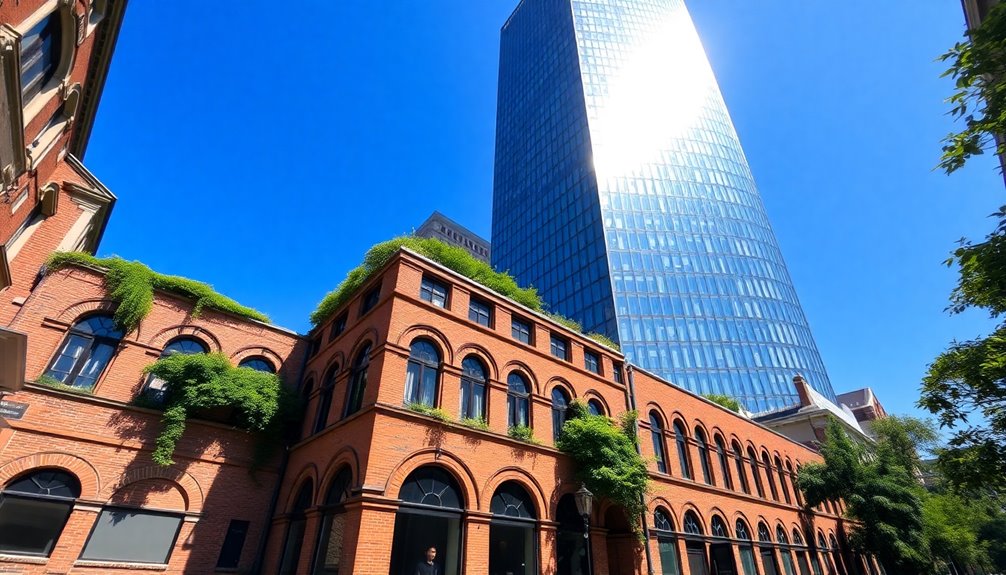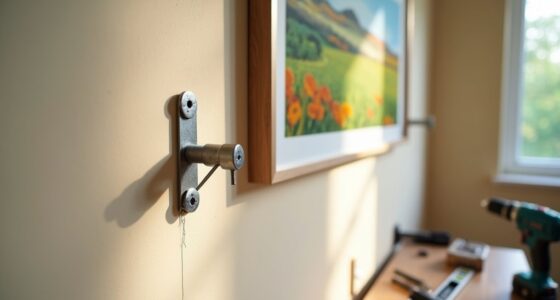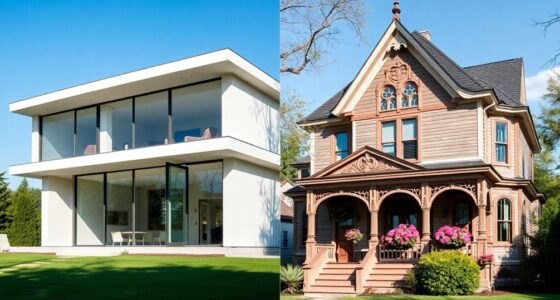To combine traditional and modern architecture harmoniously, start by blending key elements from both styles. Use traditional features like arches or intricate details alongside modern open spaces and clean lines. Mix materials, such as polished glass with warm woods, to create visual contrast and depth. Incorporating sustainable practices, like energy-efficient systems and eco-friendly materials, keeps your designs modern and responsible. Employ a neutral color palette for cohesion while ensuring a balance of symmetry and functionality. This approach connects heritage with contemporary needs, and you'll find even more tips and techniques as you explore further.
Key Takeaways
- Incorporate traditional elements like arches and decorative details into modern designs for a balanced aesthetic that honors heritage.
- Use a neutral color palette to seamlessly blend diverse materials, enhancing cohesion between traditional and modern styles.
- Experiment with mixing materials, such as warm woods with sleek metals, to create visual depth and inviting spaces.
- Focus on open living spaces that promote social interaction while incorporating traditional symmetry for a harmonious layout.
- Implement sustainable practices, such as eco-friendly materials and energy-efficient systems, to reflect modern values without sacrificing historical integrity.
Importance of Architectural Fusion

Architectural fusion is essential because it balances the preservation of cultural heritage with the demands of modern living.
By blending modern and traditional architectural styles, you create visually appealing spaces that reflect a community's cultural identity. This approach not only enhances aesthetic value but also fosters a sense of belonging among residents.
Incorporating sustainable practices from both styles leads to eco-friendly designs that minimize environmental impact, ensuring that your buildings respect historical context.
Merging these styles opens doors to unique architectural expressions, providing innovative solutions that meet contemporary needs while honoring the past.
Ultimately, architectural fusion encourages collaboration among designers and builders, ensuring that both modern functionality and historical significance shine through in new developments. Additionally, the use of natural materials in both traditional and modern designs can create a seamless connection to the environment.
Key Elements of Traditional Architecture
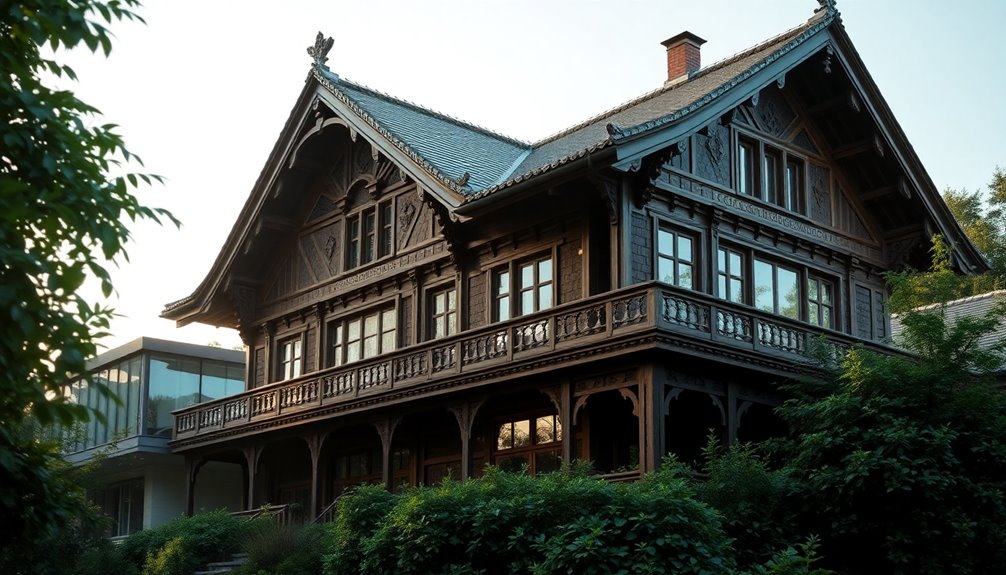
When you think about traditional architecture, you'll notice its emphasis on symmetry and proportion, creating a sense of balance in every structure.
Intricate decorative details add character and visual interest, while closed living spaces promote privacy and functional design.
These key elements not only reflect historical living patterns but also showcase the craftsmanship that defines traditional architecture.
Symmetry and Proportion
Symmetry and proportion are central to the allure of traditional architecture, as they create a sense of balance that draws the eye.
In traditional designs, symmetry enhances aesthetic appeal, guiding your gaze across harmonious layouts. Proportion guarantees that architectural features like windows, doors, and rooms are appropriately scaled to one another, contributing to a cohesive look.
Elements such as arches and columns not only provide structural support but also add decorative grandeur, reinforcing the importance of proportion in design.
When you blend these traditional principles with modern architecture, you cultivate a harmonious blend that honors the past while embracing the present.
Intricate Decorative Details
How do intricate decorative details transform a building into a work of art? In traditional architecture, these details—like carved stonework, elaborate moldings, and handcrafted finishes—showcase exceptional craftsmanship and artistry.
Elements such as arches, columns, and cornices not only provide structural support but also enhance aesthetic grandeur, creating an enchanting visual experience.
You'll notice that symmetry and proportion play crucial roles, ensuring a harmonious balance in both layout and decoration. Ornamental elements like friezes and pediments add layers of richness and cultural significance.
Closed Living Space Design
Intricate decorative details not only enhance the aesthetic value of traditional architecture but also set the stage for the unique design of closed living spaces.
These spaces, such as parlors, dining rooms, and studies, promote privacy and distinct functional divisions, contrasting sharply with modern open-plan layouts.
You'll find that symmetrical design is a hallmark of traditional architecture, creating a balanced look that fosters a sense of order throughout your home.
Rich materials like hardwood floors and plush textiles contribute to a warm atmosphere, while intricate moldings and classic arches add visual interest.
Key Elements of Modern Architecture

What makes modern architecture stand out is its emphasis on open living spaces that promote social interaction and harness natural light.
This architectural style embraces simplicity and functionality, allowing for a seamless flow between indoor and outdoor environments.
Key elements include:
- Clean lines that create a sleek, uncluttered look
- Minimalist aesthetics that focus on essential forms
- Sustainable materials that reduce environmental impact
- Energy-efficient systems that enhance overall performance, incorporating natural materials that can also be found in farmhouse design aesthetics.
Combining Styles for Aesthetic Appeal
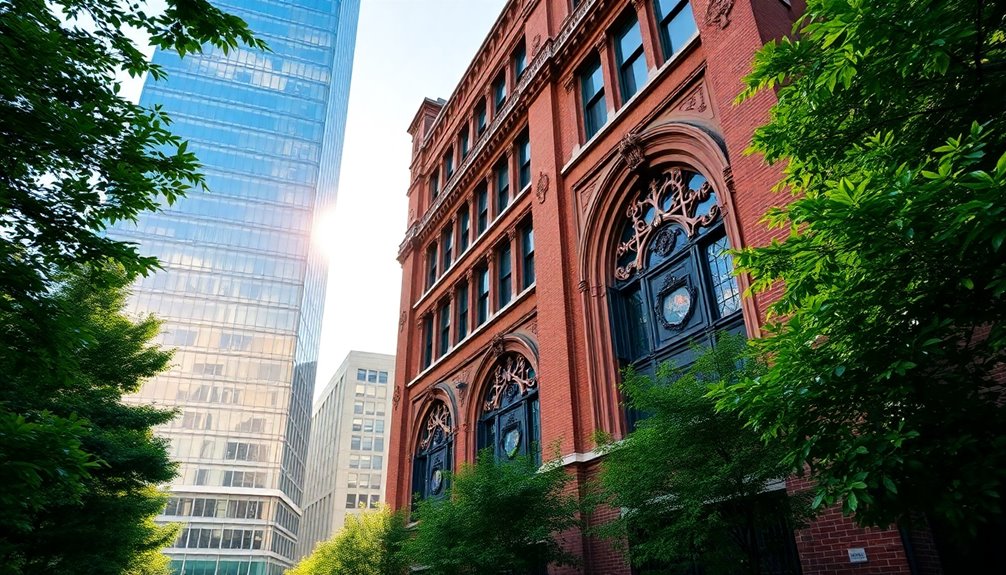
You can create a stunning aesthetic by mixing materials and furniture styles in your space. Pairing natural elements like wood with sleek metal or glass not only adds depth but also encourages harmony. Additionally, the incorporation of natural elements promotes tranquility and enhances the overall ambiance of your environment.
Material Contrast and Harmony
When you blend traditional and modern architectural styles, the contrast of materials can create an eye-catching aesthetic that captivates the senses.
By thoughtfully combining various textures and elements, you can achieve a harmonious blend that enhances your design.
- Use traditional materials like brick or timber alongside modern architectural features for depth.
- Pair natural stone with glass and metal to foster striking contrasts.
- Incorporate polished surfaces with warm, tactile elements for richness.
- Choose locally sourced, eco-friendly options to promote sustainability.
This approach not only elevates aesthetic appeal but also creates a unique space that resonates with both history and contemporary innovation.
Embrace material contrast to enrich your architectural vision and achieve a perfect balance.
Eclectic Furniture Arrangements
While blending furniture styles might seem challenging, it can create a vibrant and inviting space that reflects your personal taste.
Eclectic furniture arrangements, like pairing traditional sofas with modern accent chairs, enhance visual interest and prevent a disjointed look. You can seamlessly integrate traditional dining tables into modern settings, maintaining a cohesive aesthetic that honors both styles.
To achieve a harmonious atmosphere, strategically place furniture to guarantee no single design dominates. Incorporating contrasting textures and finishes, such as sleek metal alongside rustic wood, enriches the visual depth of your space. Additionally, consider using vintage and antique furnishings to further enhance the character and authenticity of your eclectic design.
Practical Design Applications
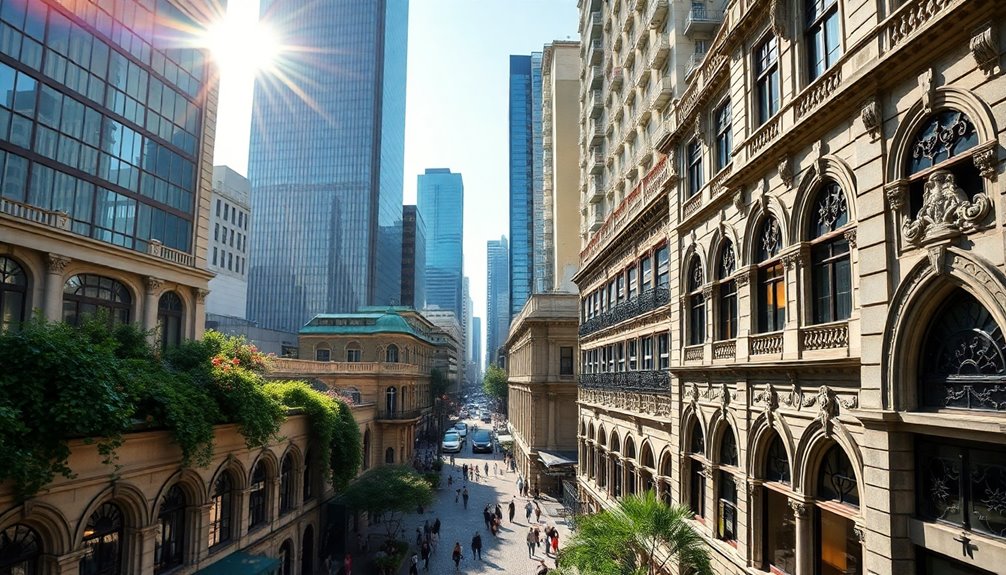
By blending traditional architectural features with modern design elements, you can create spaces that aren't only visually appealing but also rich in character.
Consider these practical design applications to achieve a harmonious balance of modern and traditional styles:
- Incorporate traditional elements like arches and moldings for visual interest.
- Use a neutral color palette to seamlessly blend materials and furniture.
- Experiment with mixing materials, pairing natural stone or wood with contemporary finishes.
- Design open spaces that emphasize traditional symmetry while promoting modern functionality.
These strategies can help you create a cohesive environment that celebrates both modern and traditional aesthetics, ensuring your space feels inviting and timeless. Additionally, a focus on sustainability and efficient resource use can enhance the overall design and functionality of your space.
Role of Professionals in Design
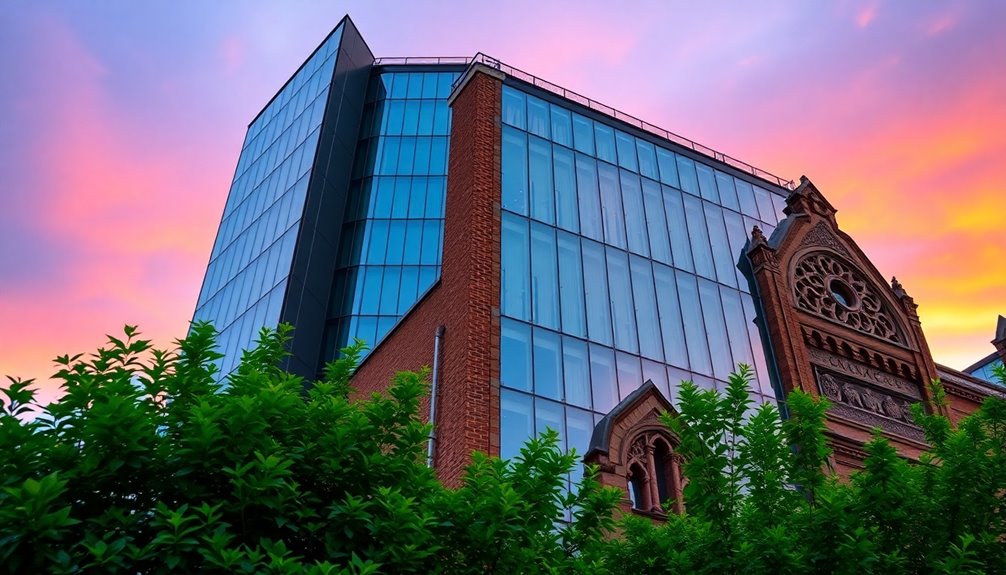
Incorporating the expertise of architects and designers is essential for successfully blending traditional and modern architecture. These professionals guarantee that design principles harmonize, creating unique and functional spaces.
They excel in material selection, helping you choose sustainable and innovative options that enhance both aesthetics and durability. By providing insights into current trends, they enable you to integrate smart home features seamlessly into your custom home.
Collaborating with experienced builders guarantees your designs reflect your individual preferences while maintaining a cohesive architectural style. Additionally, professionals can share case studies and examples from previous projects, inspiring you and assuring a successful fusion of traditional architecture with modern elements in your design. Furthermore, understanding the importance of seasonal produce can help in selecting materials that resonate with the surrounding environment and enhance the overall design concept.
Sustainable Practices in Architecture
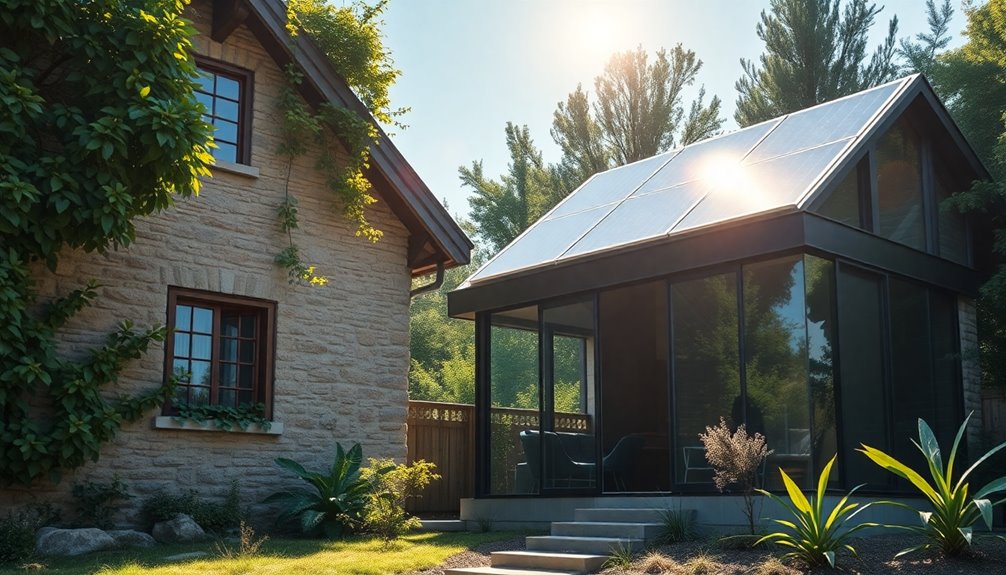
Blending traditional and modern architecture offers a unique opportunity to embrace sustainable practices that benefit both the environment and your design.
By integrating sustainable architecture principles, you can create spaces that aren't only beautiful but also eco-friendly.
Consider these practices:
- Use eco-friendly materials like reclaimed wood and recycled steel to enhance aesthetics and reduce waste.
- Incorporate energy-efficient systems, such as solar panels and green roofs, to lower energy consumption.
- Apply passive design strategies, maximizing natural light and ventilation to improve indoor air quality.
- Embrace adaptive reuse, repurposing old buildings to preserve history and minimize new construction impacts.
- Additionally, utilizing renewable wood fuel for heating can further reduce your building's carbon footprint and contribute to a greener environment.
Mixing Materials and Textures
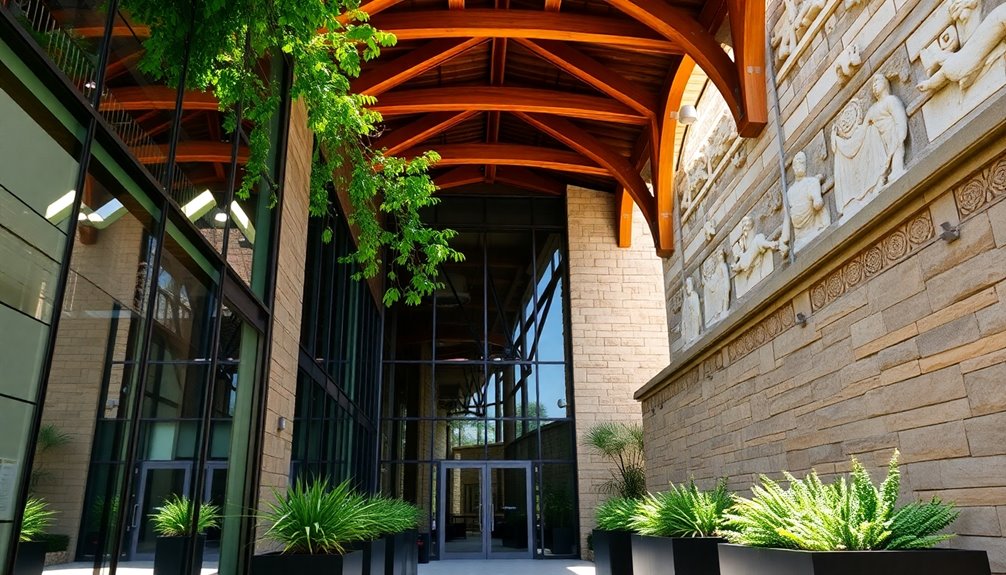
When you mix materials like polished glass with warm wood, you create a striking contrast that draws the eye.
This combination not only enhances the visual depth of your design but also fosters a sense of harmony between traditional and modern elements. Additionally, being aware of early detection can help ensure that health concerns are addressed promptly, just as thoughtful design careful considers the interplay of its components.
Diverse Material Combinations
Combining diverse materials can transform architectural designs into visually stunning spaces. By mixing modern materials like glass and metal with traditional materials such as natural stone and wood, you create striking contrasts that enhance aesthetic appeal.
This thoughtful experimentation fosters a harmonious balance, merging contemporary tastes with historical craftsmanship. Effective preparation for selecting these materials ensures a well-integrated design process.
- Use polished surfaces like marble alongside warm woods for richness.
- Incorporate natural fibers to add tactile variation.
- Combine timber and render with sleek finishes for depth.
- Explore unique pairings that resonate with both styles.
These diverse material combinations promote textural variation, making spaces feel dynamic and inviting.
Embrace this approach to create cohesive and interesting environments that capture the essence of both modern and traditional design principles.
Textural Depth Enhancement
Textural depth is essential in creating spaces that resonate with warmth and sophistication. You can achieve textural depth enhancement by blending traditional materials like warm wood and natural fibers with modern design elements such as polished stone or glass.
This combination creates a visually stunning environment that captivates the senses. Incorporating diverse textures, like soft textiles alongside sleek metals, adds depth and interest, fostering a balanced visual experience.
The contrast between smooth and tactile materials creates a dynamic atmosphere, making your space inviting yet sophisticated. Experimenting with these material combinations not only yields unique results but also reflects your personal style, showcasing your taste and creativity in a harmonious blend of the old and new. Additionally, effective lighting design can further enhance the visual impact of these textures, creating a cohesive and inviting ambiance in your space.
Creating Balance and Harmony

Achieving balance and harmony in design requires a thoughtful distribution of traditional and modern elements throughout your space.
By carefully blending these styles, you can create a cohesive environment that feels inviting and visually appealing.
Consider these key strategies for maintaining balance:
- Use symmetrical arrangements to enhance order and tranquility.
- Mix materials—pair sleek metals with warm woods for enriching contrast.
- Establish a neutral color palette, allowing vibrant accents to shine.
- Incorporate statement pieces as focal points to connect the two styles.
Future of Architectural Design
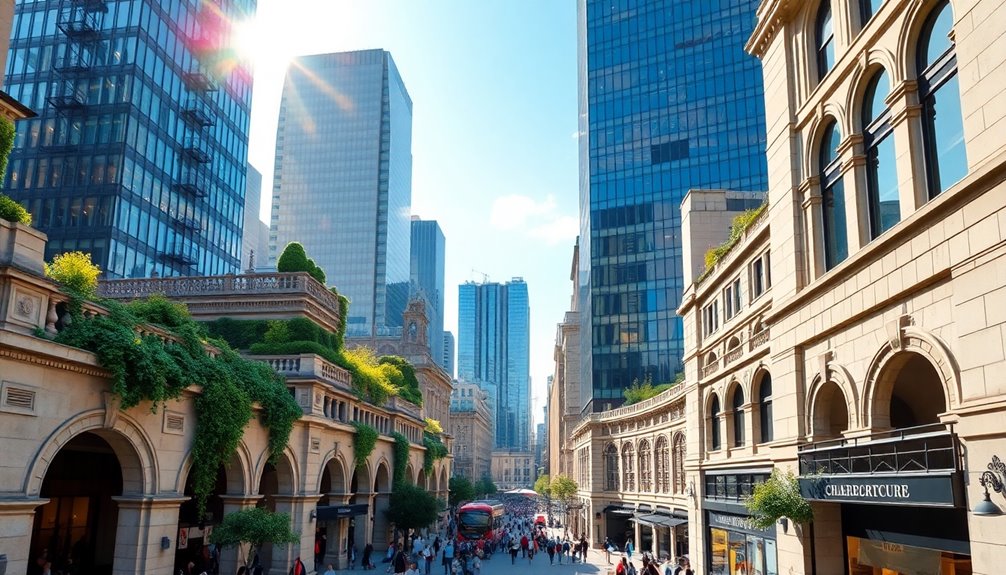
As the world evolves, the future of architectural design promises to blend traditional and modern elements in ways that honor cultural heritage while addressing contemporary needs. You'll see a focus on sustainability without sacrificing aesthetic appeal, combining traditional craftsmanship with innovative energy-efficient structures. Cities will transform into living narratives, showcasing the rich heritage alongside contemporary architecture.
| Focus Area | Traditional Elements | Modern Innovations |
|---|---|---|
| Design Approach | Culturally rich architecture | Versatile, functional spaces |
| Sustainability | Historical techniques | Eco-friendly materials |
| Preservation Techniques | Conservation of heritage | Technology-driven revitalization |
This harmonious blend not only enhances living environments but also creates a unique architectural identity for future generations.
Frequently Asked Questions
Can Traditional and Modern Architecture Coexist?
Yes, traditional and modern architecture can absolutely coexist.
You'll find that incorporating elements like symmetry from traditional designs into the sleek lines of modern structures creates a fascinating balance.
By fusing materials, such as natural stone with glass, you enhance visual appeal.
Adding details like mouldings can bring character to contemporary designs.
Cities worldwide showcase this blend, proving that respecting history while embracing modernity can lead to vibrant and harmonious urban landscapes.
What Is the Combination of Traditional and Modern Design Called?
Have you ever wondered how classic and contemporary styles can coexist beautifully? The combination of traditional and modern design is known as “transitional design. ” Transitional design seamlessly blends the elegance of classic design vs modern design, creating spaces that feel both timeless and fresh. This approach allows for the use of traditional elements, such as ornate moldings or rich fabrics, alongside sleek lines and minimalist decor. The result is a harmonious environment that appeals to a wide range of tastes and preferences, inviting comfort and sophistication.
This approach blends elements from both styles, creating a cohesive look that feels balanced and inviting. You'll see traditional furniture paired with sleek modern decor, neutral color palettes accented by bold pops, and natural materials harmonizing with glass and metal.
It's all about achieving a rich, textured experience in your space.
What Is the Fusion of Tradition and Modernity?
The fusion of tradition and modernity is all about blending historical architectural elements with contemporary designs.
You'll see this in the use of symmetry and intricate details alongside clean lines and open spaces.
By incorporating materials like wood and stone with glass and metal, you create visually appealing structures.
This approach not only respects cultural heritage but also adapts to modern functionality, resulting in spaces that honor the past while meeting today's needs.
What Is the Blend of Traditional and Contemporary?
The blend of traditional and contemporary architecture creates a unique visual experience.
You'll notice classic elements like intricate mouldings or arches paired with sleek, minimalist designs.
By mixing materials such as wood and glass, you enhance both styles' appeal.
Color schemes also play an essential role; warm, muted tones can complement bold, vibrant hues.
This fusion not only respects historical craftsmanship but also embraces modern innovation, resulting in spaces that are both inviting and functional.
Conclusion
In the grand tapestry of architecture, blending traditional and modern styles offers a delightful journey into creativity. By thoughtfully intertwining elements from both worlds, you can craft spaces that not only captivate the eye but also warm the heart. Embrace the art of fusion, where every beam and brick tells a story, and every corner invites you to explore. As you step into this harmonious domain, you'll find that the future of design is as limitless as your imagination.
